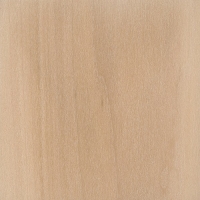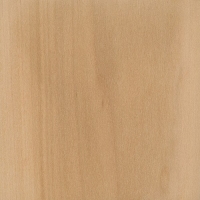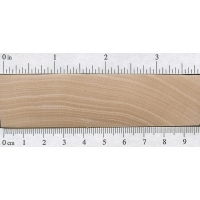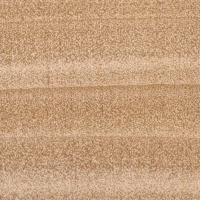
Common Name(s): Rowan, Service Tree, Checker Tree
Scientific Name: Sorbus spp. (S. aucuparia, S. domestica, S. torminalis)
Distribution: Primarily Europe; some species are also present in
North America, northern Africa, and Asia
Tree Size: 30-50 ft (9-15 m) tall, 8-16 in (20-40 cm) trunk diameter
Average Dried Weight: 48 lbs/ft3 (770 kg/m3)
Specific Gravity (Basic, 12% MC): .64, .77
Janka Hardness: 1,690 lbf (7,520 N)*
*Estimated hardness based on specific gravity.
Modulus of Rupture: 17,300 lbf/in2 (119.3 MPa)
Elastic Modulus: 1,490,000 lbf/in2 (10.28 GPa)
Crushing Strength: 8,410 lbf/in2 (58.0 MPa)
Shrinkage: Radial: 6.2%, Tangential: 8.4%, Volumetric: 15.0%, T/R Ratio: 1.4
Color/Appearance: No data available.
Grain/Texture: No data available.
Endgrain: Diffuse-porous (or sometimes semi-ring-porous with a greater concentration of pores in earlywood); exclusively solitary (or sometimes in multiples); small pores in no specific arrangement, very numerous; parenchyma not visible with lens; narrow rays, spacing fairly close.
Rot Resistance: No data available.
Workability: No data available.
Odor: No characteristic odor.
Allergies/Toxicity: Besides the standard health risks associated with any type of wood dust, no further health reactions have been associated with Rowan. See the articles Wood Allergies and Toxicity and Wood Dust Safety for more information.
Pricing/Availability: No data available.
Sustainability: This wood species is not listed in the CITES Appendices or on the IUCN Red List of Threatened Species. Although S. aucuparia is not listed on the IUCN Red List, there’s a number of obscurer species with varying levels of endangerment.
Common Uses: No data available.
Comments: S. aucuparia wood is fluorescent, while S.torminalis is reportedly not.
None available.
None available.
Scans/Pictures: A special thanks to Steve Earis for providing the wood sample and turned photo of this wood species.








Here in Southeast Alaska, there is Sorbus Sitchensis and the European Sorbus Aucuparia. The trees can reach more than a foot in diameter and are very hard and dense. I have turned it, and it cuts beautifully, like green apple. The texture is very fine, it is my favorite wood to turn. It mostly grows in town, but supposedly grows wild too.
Scandinavia has its own endemic spiecies of the sorbus genus (Sorbus intermedia) more commonly nown as Oxel and its a very hard and durable wood much harder than for exaple Oak. it was for a long time used for folding rulers, the name is beleived to come from axel as in centerpiese for turning weel.
The tree is common but the wood is very difficult to come by..
Sorbus domestica is much heavier than the other Sorbus subspecies, supposedly 0.88g per cubic centimetre completely dry (0% moisture) according to two sources including Janka’s book, and accordingly heavier at 12% moisture. It’s often referred to as the heaviest (central) European wood. Janka gives the hardness at 1014 kg (about 2200 lbs), but he seems to have had only a few samples. Sorbus domesticus has become endangered in most regions – I’ve even read it is supposedly the rarest tree species in Europe – and is only rarely sold as lumber. It is quite sought-after for certain applications such as… Read more »
There certainly does seem to be a lot of confusion about the sorbus family, possibly largely due to natural hybridisation giving rise to so many local variants. However, grouping all the sorbus trees under the name “rowan” only adds to the confusion, because what is most commonly known as rowan (Sorbus acuparia) is only one of the many trees in the Sorbus genus. It’s sometimes called mountain ash because of the superficial similarity of the leaves to real ash, but it’s worth noting that the leaves of Sorbus acuparia have serrated edges, unlike real ash leaves. Then there are the… Read more »
Thank you Sacha.
I would add that Sorbus domestica known as “Cormier” in France is a beautifull dark wood used for centuries to make tools such as wooden planes (I believe this is specific to France). Therefore it has little to do with “Rowan” in appearance.
I think this excellent database would benefit from segregating all these Sorbus.
I believe what is known as Swiss pear is actually service tree, sorbus sp. (probably torminalis). Usually it’s sold steamed which gives it a orange-pinkish color. It resembles true pearwood (pyrus sp.) being fine textured with indistinct growth lines, but can grow to shade tree size yielding much larger planks, mostly clear of knots, unlike pear. There’s much confusion online, even one reputable dealer claiming it’s “pyrus sorbus.” If anyone knows for certain please comment.
What is certain is that pear can be grafted onto sorbus aria (whitebeam) rootstock, and the two hybridised in Alsace in the 17th century to produce the “Shipova” pear, which has since been propagated by grafting. I can only imagine that this is the same as “Swiss pear”, which seems to have been given various unconfirmed botanical names over the years. This article explains more, but unfortunately with no reference to the wood: https://davesgarden.com/guides/articles/view/1795
I’m glad there are people like you out there doing your thing, all the rest of us benefit from your lifetime of work. I can never really stay with anything that long.
Here in Canada this tree is known both as Mountain Ash and Rowan. In British Columbia, where I live, it grows wild and is plentiful. Last week I encountered a fresh cut pile left by a Hydro crew on a mountain near here — I took home several lengths, which I am using for greenwood carving (mostly spoons). It is a pleasure to carve, not too hard, plane cuts nicely, nice buff colour and figuring when dry. Resembles maple in some ways.
It is known as Mountain Ash (do not know why, as you pointed out is not actually ash)…mountain ash is also the name for Eucalyptus regnans, which is a totally different tree…We have got some Rowan here in Spain, but is not a really common tree, so I understand why Eric suggests it could be in a way endangered.
I think it`s called mountain ash as its leaves are similar to ash, and in Europe it grows at higher altitudes than “normal” ash. More of a vernacular name than botanically…
I don’t know about “wood world”, but in “plant world/tree world”, the Rowan is known most commonly as: Mountain Ash. As you already know…it is not an Ash tree, but it is still mostly referred to as: Mountain Ash, here in the USA. I own a tree and shrub nursery and have been in the industry, for over 40 years, and almost 100% of the time someone is looking for this tree, to plant, they will ask for a Mountain Ash. PS: I love your book and website.